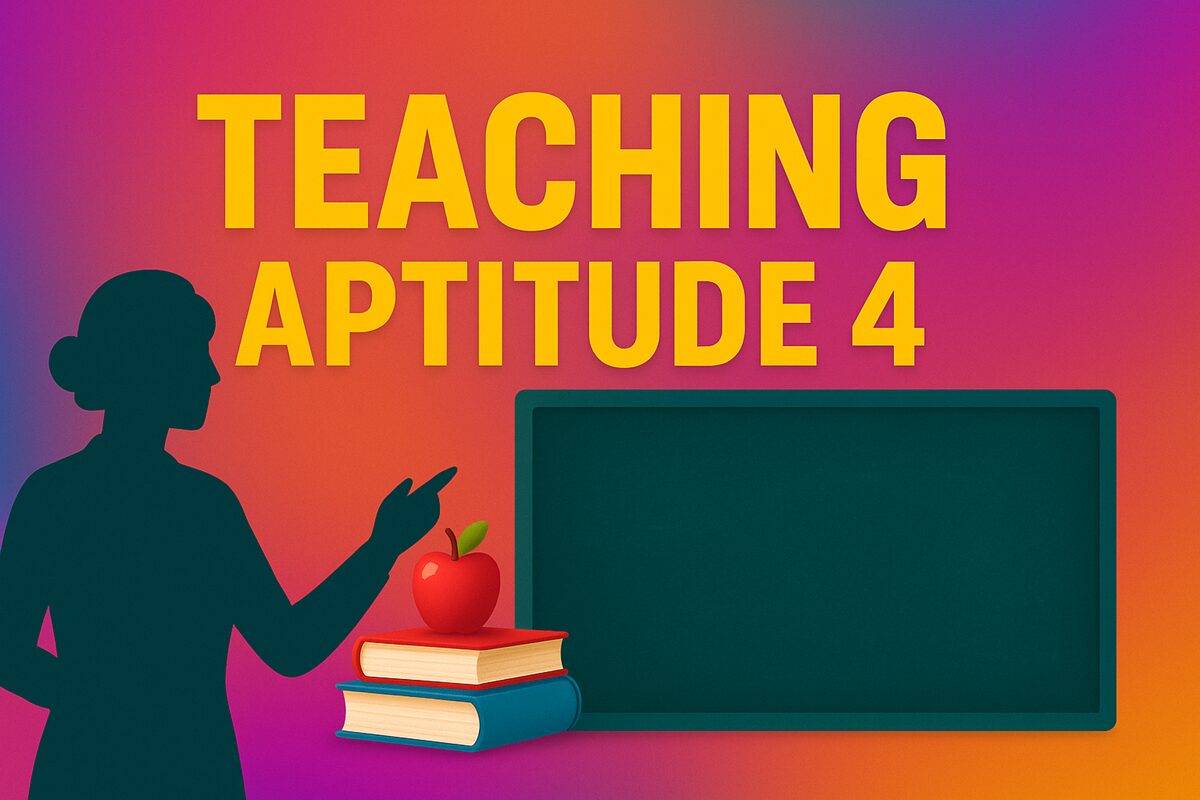Teaching Aptitude 4: 1. तुलना-सारणी: मुख्य Teaching Methods
| # | विधि / Method | सार-संकल्प / Essence | मुख्य गुण / Merits | सीमाएँ / Demerits |
|---|---|---|---|---|
| 1 | खुरीस्टिक / Heuristic | “खोजो-सीखो” – learner discovers rules | ▸ Scientific attitude develops ▸ Self-reliance & curiosity | ▸ Slow pace ▸ Needs well-trained teacher ▸ Large classes→difficult |
| 2 | प्रोजेक्ट / Project | Real-life project in group | ▸ Cooperation, social skills ▸ Learner autonomy ▸ Creativity | ▸ Time-consuming ▸ Syllabus coverage tough ▸ Record-keeping burden |
| 3 | प्रेक्षण / Observation | Watch → Note → Conclude | ▸ Real phenomena, keen senses ▸ Interest ↑ | ▸ Not fit for civics etc. ▸ Equipment/time demands |
| 4 | समस्या-समाधान / Problem-Solving | Identify → Analyse → Solve | ▸ Reasoning & concepts clear ▸ Scientific temper | ▸ Not for all topics ▸ Needs mature learners |
| 5 | आगमन / Inductive | Particular → General rule | ▸ Concept formation solid ▸ Creativity | ▸ Time-heavy ▸ Rule generalisation tricky |
| 6 | न्यासागमन / Deductive | Rule → Examples → Verify | ▸ Fast ▸ Systematic | ▸ Abstract for young kids ▸ Less discovery |
| 7 | खेळ-विधि / Play-Way | Game-based joyful learning | ▸ Motivation, energy ▸ Social & motor skills | ▸ Limited to primary ▸ Noise & control issues |
| 8 | प्रयोगशाला / Laboratory | Hands-on experiment | ▸ Scientific skills ▸ Concrete understanding | ▸ Costly ▸ Class-size limits |
| 9 | असाइनमेंट / Assignment | Home/School tasks | ▸ Responsibility ▸ Independent study | ▸ Teacher load ▸ Copy risk |
नई दिशा / New Trend (NEP-2020) – Experiential & toy-based learning; projects linked to SDGs; virtual labs via DIKSHA platform.
2. चरण-स्मरण (Steps) – Project Method Example
- समस्या चयन / Select Problem
- योजना बनाना / Planning
- कार्यान्वयन / Execution
- मूल्यांकन-प्रस्तुति / Evaluation & Report
(Mnemonic: S-P-E-E) – Select-Plan-Execute-Evaluate.
3. Teaching Aids – शिक्षण सहायक सामग्री
| वर्गीकरण / Classification | उदाहरण / Examples | उद्देश्य / Purpose |
|---|---|---|
| दृश्य (Visual) | चार्ट, मॉडल, स्लाइड, फ्लैश-कार्ड | See → Remember |
| श्रव्य (Audio) | Radio, Podcast, Recorder | Hear → Understand |
| श्रव्य-दृश्य (Audio-Visual) | TV, Computer, Video, Smart-board | Multi-sensor impact |
| स्पर्श/अनुभूति (Tactile/Kinesthetic) | Science kit, Toy-based aids | Hands-on learning |
2024 Update: VR-headsets & AR-apps now accepted as advanced audio-visual aids in CBSE skill labs.
4. Quick-Reference – परीक्षा पॉइंट्स
| Topic asked in TET/PRT | याद टिप / Quick Key |
|---|---|
| “Merits of Heuristic” | Self-learning, scientific attitude |
| “Play-way सिद्धांत” | Freedom, activity, socialisation |
| “Assignment विधि का उद्देश्य” | Responsibility & study habits |
| “Teaching Aids senses” | Visual-Audio-AudioVisual-Tactile |
| “Inductive vs Deductive rule” | Particular→General vs General→Particular |
5. चयन-सूत्र / Method Selection Factors
| कारक / Factor | हिन्दी संकेत | English Hint |
|---|---|---|
| उद्देश्य | कौशल या ज्ञान? | Skill vs knowledge |
| कक्षा-आकार | बड़ी / छोटी? | Large / small class |
| समय व साधन | अवधि, संसाधन | Time, resources |
| विषय-प्रकृति | अमूर्त या ठोस | Abstract or concrete |
| शिक्षार्थी स्तर | आयु, रुचि | Age, interest |
(Formula: O-C-S-S-L → Objective, Class-size, Support, Subject, Learner.)
6. संक्षिप्त निष्कर्ष / Conclusion
Follow NEP 2020 emphasis on experiential, digital and inclusive methods for future-ready classrooms.
Learner-Centric moves (Heuristic, Project, Play-Way) build creativity but need time & planning.
Teacher-Centric tools (Lecture, Deductive) cover syllabus fast but may lower participation.
Combine Teaching Aids for multi-sensory impact.
Teaching Aptitude 4 – Educational Interest Test 4 प्रत्येक उत्तर के +1 पॉइंट आपको मिलेंगे और गलत उत्तर के 0 पॉइंट, START TEST का बटन दबाकर आप TEST को शुरू कर सकते हैं उत्तर सही होने पर हरा रंग का उत्तर दिखेगा गलत होने पर लाल रंग का उत्तर दिखेगा अंत में FINISH TEST का बटन दबाकर टेस्ट को समाप्त करे, और आपने कितने अंक प्राप्त किए उसे देखें

